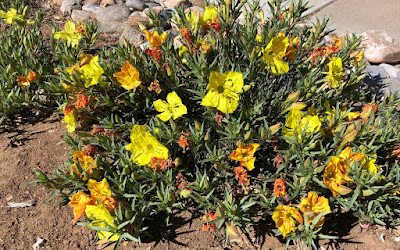 |
| Fendler’s Sundrops (Calylophus hartwegii fendleri) flourishing along our front walkway. The oldest of 6 plants has bloomed for months already without any human watering. |
"Landowners are using nonnative plants in
their yards because they're pretty and exotic,
they're easy to maintain,
and they tend to have fewer pests on them.
But it turns out that a lot of those insects they see as pests
are actually critical food resources
for our breeding birds.
For landowners who want to make a difference,
our study shows that a simple change
they make in their yards
can be profoundly helpful for bird conservation."
Smithsonian Conservation Biology Institute researcher.
The study is the first
to directly link the decline of common resident bird species
to the lack of insect prey
that results
from the use of nonnative plants in landscaping.
At a recent local gathering I was talking with an individual who works for the National Park Service and he reiterated that at least 70% natives in the garden is needed for the health and well BEing of our native fauna. It seems those interested in curbing the radical decline of diversity in our birds, insects and animal are well aware of the importance of native habitat. Intuitively it has always made sense to me to grow what is native to the area in which I was gardening rather than nonnatives, aka exotics. I have found it very exciting to learn about the plants of the Southwest and all the visitors they invite. And these plants are beautiful to the human eye, as well, which numerous passerbys comment to me if I am working out in the front garden.
Here at MuRefuge 6970' the front is 100% native flora so no worries about welcoming birds, insects, including butterflies and moths, as well as rabbits, skunks and raccoons. I see hummingbirds nectaring on the plethora of blooming penstamons. There is a pair of Lesser Goldfinches who I have observed eating the seeds from the dried flower pods of the Rocky Mountain Penstamons. And Dwight in the late evening has seen a hawkmoth on the Tufted Evening Primrose which is larva food for a specific type of this awesome BEing.
 |
| Praying Mantis on our adobe wall. I have also seen one of these stunning BEings in the Paperflower blossoms (the mound of yellow flowers pictured below).  |
In addition to annual edibles (pictured above) an orchard has been planted as well as berries.
 |
| Purple Prairie Clover (Dalea purpurea) which is also a nitrogen fixing plant hence the reason to plant it amidst the red raspberries (depicted here) as well as blackberries. |
These exotics are balanced with a variety blooming native perennials and grasses which I find very pleasing to my senses. And Shasta loves lying in the midst of the Desert 4 o'clocks which surround the Desert Willow.
 | |
| Desert Willow (Chilopsis linearis ‘Bubba’) which is not really a willow at all but of the Catalpa family. Looking closely at the above flowers you will notice they look remarkably like the Catalpa tree flowers as do the seeds pods which develop in the Fall. |
 |
| Serviceberry (Amelanchier alnifolia) with her berries just ready for the enjoyment of the fruit eating birds.
at absurd human behavior.
|




No comments:
Post a Comment